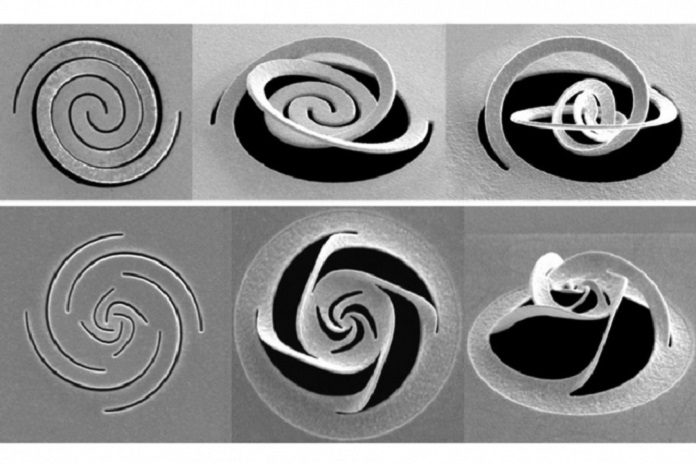Nanokirigami is based on the ancient arts of origami (making 3-D shapes by folding paper) and kirigami (which allows cutting as well as folding) but applied to flat materials at the nanoscale, measured in billionths of a meter.
Using this technique, MIT and China scientists have developed nanodevices to manipulate light, potentially opening up new possibilities for research and, ultimately, the creation of new light-based communications, detection, or computational devices.
Scientists used methods based on standard microchip manufacturing technology and focused ion beam in order to create a precise pattern of slits in a metal foil just a few tens of nanometers thick. The procedure makes the thwart twist and curve itself into a mind-boggling three-dimensional shape able to do specifically sifting through light with a specific polarization.
For these initial proof-of-concept devices, the team produced a nanomechanical equivalent of specialized dichroic filters that can filter out circularly polarized light either “right-handed” or “left-handed.” To do so, they created a pattern just a few hundred nanometers across in the thin metal foil; the result resembles pinwheel blades, with a twist in one direction that selects the corresponding twist of light.
MIT professor of mechanical engineering Nicholas X Fang said, “Previous attempts to create functional kirigami devices have used more complicated fabrication methods that require a series of folding steps and have been primarily aimed at mechanical rather than optical functions. The new nanodevices, by contrast, can be formed in a single folding step and could be used to perform several different optical functions.”
Fanf explained, “The twisting and bending of the foil happens because of stresses introduced by the same ion beam that slices through the metal. When using ion beams with low dosages, many vacancies are created, and some of the ions end up lodged in the crystal lattice of the metal, pushing the lattice out of shape and creating strong stresses that induce the bending.”
“It’s a very nice connection of the two fields, mechanics and optics. The team used helical patterns to separate out the clockwise and counterclockwise polarized portions of a light beam, which may represent “a brand new direction” for nanokirigami research.”
The research is still at an early stage, so more research will be needed on possible applications. But these devices are orders of magnitude smaller than conventional counterparts that perform the same optical functions, so these advances could lead to more complex optical chips for sensing, computation, or communications systems or biomedical devices.
Journal Reference:
- Zhiguang Liu, Huifeng Du, Jiafang Li et al. Nano-kirigami with giant optical chirality. Science Advances. DOI: 10.1126/sciadv.aat4436
